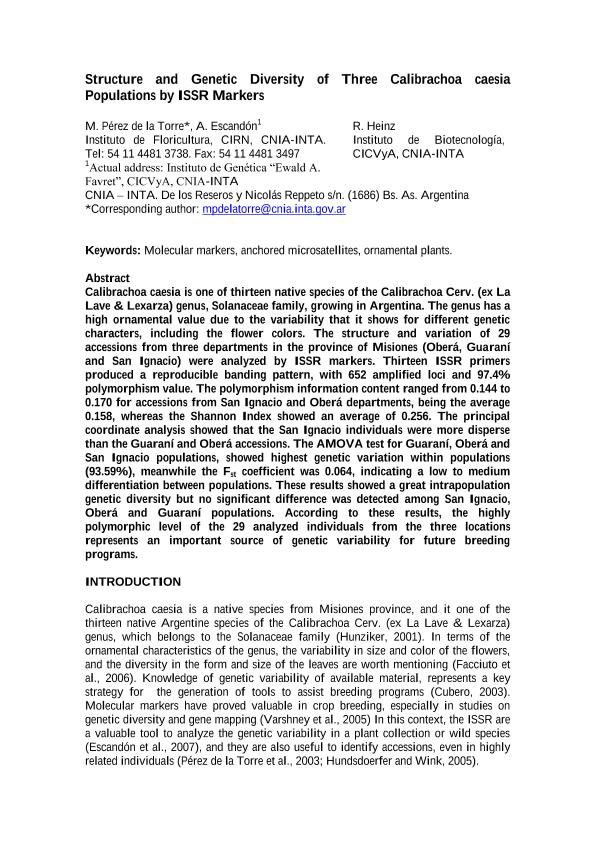Artículo
Structure and genetic diversity of three Calibrachoa caesia populations by ISSR markers
Fecha de publicación:
09/2013
Editorial:
International Society for Horticultural Science
Revista:
Acta Horticulturae
ISSN:
0567-7572
Idioma:
Inglés
Tipo de recurso:
Artículo publicado
Clasificación temática:
Resumen
Calibrachoa caesia is one of thirteen native species of the Calibrachoa Cerv. (ex La Lave & Lexarza) genus, Solanaceae family,growing in Argentina. The genus has a high ornamental value due to the variability that it shows for different genetic characters, including the flower colors. The structure and variation of 29 accessions from three departments in the province of Misiones (Oberá, Guaraní and San Ignacio) were analyzed by ISSR markers. Thirteen ISSR primers produced a reproducible banding pattern, with 652 amplified loci and 97.4% polymorphism value. The polymorphism information content ranged from 0.144 to 0.170 for accessions from San Ignacio and Oberá departments, being the average 0.158, whereas the Shannon Index showed an average of 0.256. The principal coordinate analysis showed that the San Ignacio individuals were more disperse than the Guaraní and Oberá accessions. The AMOVA test for Guaraní, Oberá and San Ignacio populations, showed highest genetic variation within populations (93.59%), meanwhile the Fst coefficient was 0.064, indicating a low to medium differentiation between populations. These results showed a great intrapopulation genetic diversity but no significant difference was detected among San Ignacio, Oberá and Guaraní populations. According to these results, the highly polymorphic level of the 29 analyzed individuals from the three locations represents an important source of genetic variability for future breeding programs.
Palabras clave:
Anchored
,
Microsatellites
,
Molecular
,
Markers
,
Ornamental
,
Plants
Archivos asociados
Licencia
Identificadores
Colecciones
Articulos(SEDE CENTRAL)
Articulos de SEDE CENTRAL
Articulos de SEDE CENTRAL
Citación
Perez de la Torre, Mariana Cecilia; Heinz, Ruth Amelia; Escandón, Alejandro Salvio; Structure and genetic diversity of three Calibrachoa caesia populations by ISSR markers; International Society for Horticultural Science; Acta Horticulturae; 100; 9-2013; 439-444
Compartir
Altmétricas




